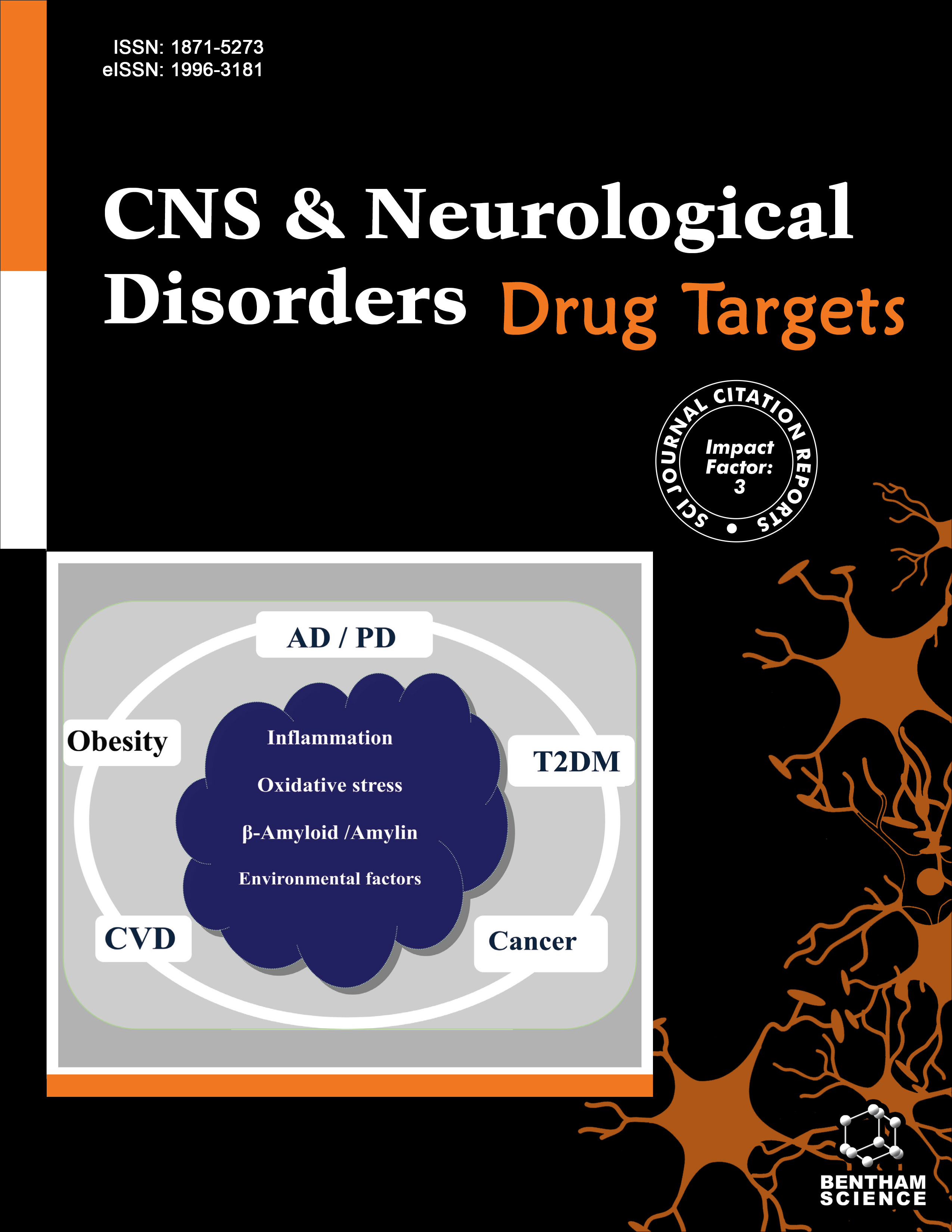- Home
- A-Z Publications
- CNS & Neurological Disorders - Drug Targets (Formerly Current Drug Targets - CNS & Neurological Disorders)
- Previous Issues
- Volume 7, Issue 2, 2008
CNS & Neurological Disorders - Drug Targets (Formerly Current Drug Targets - CNS & Neurological Disorders) - Volume 7, Issue 2, 2008
Volume 7, Issue 2, 2008
-
-
Editorial [ Role of Ion Channels in Neurological Disorders Guest Editor: Johannes J. Krupp ]
More LessIon channels are a key target class for the pharmaceutical industry and available drugs that target ion channels combine clinical benefit with commercial success. Primary research is continuously uncovering potential new ion channel targets in virtually all possible disease indications, including numerous neurological disorders. This trend is expected to continue for a long time to come: ion channels are at the center of Read More
-
-
-
Ion Channel Screening Technology
More LessIon channels are at present the third biggest target class in drug discovery. Primary research is continually uncovering potential new ion channel targets in indications such as cancer, diabetes and respiratory diseases, as well as the more established fields of pain, cardiovascular disease, and neurological disorders. Despite the physiological significance and therapeutic relevance in a wide variety of biological systems, ion chan Read More
-
-
-
Ionotropic Glutamate Receptors & CNS Disorders
More LessBy Derek BowieDisorders of the central nervous system (CNS) are complex disease states that represent a major challenge for modern medicine. Although aetilogy is often unknown, it is established that multiple factors such as defects in genetics and/or epigenetics, the environment as well as imbalance in neurotransmitter receptor systems are all at play in determining an individual's susceptibility to disease. Gene therapy is cu Read More
-
-
-
Voltage-Gated Sodium Channels in Neurological Disorders
More LessAuthors: Mohamed Chahine, Aurelien Chatelier, Olga Babich and Johannes J. KruppVoltage-gated sodium channels play an essential biophysical role in many excitable cells such as neurons. They transmit electrical signals through action potential (AP) generation and propagation in the peripheral (PNS) and central nervous systems (CNS). Each sodium channel is formed by one α-subunit and one or more β-subunits. There is growing evidence indicating that mutations, changes in expression, or inappropriate mo Read More
-
-
-
Transient Receptor Potential Vanilloid 1 and Xenobiotics
More LessAuthors: E. Cuypers, M. Dabrowski, L. Horoszok, G. E. Terp and J. TytgatOver the last couple of years, transient receptor potential vanilloid 1(TRPV1) channels have been a hot topic in ion channel research. Since this research field is still rather new, there is not much known about the working mechanism of TRPV1 and its ligands. Nevertheless, the important physiological role and therapeutic potential are promising. Therefore, extensive research is going on and a lot of natural as well as synth Read More
-
-
-
Protein-Protein Interactions and Subunit Composition of Ion Channels
More LessBy Uwe SchulteIon channels are integral membrane proteins that enable the passive flow of inorganic ions by forming hydrated pores across biological membranes. Their pore-forming alpha subunits determine ion permeation and provide the machinery for gating. In addition, channel class specific accessory proteins termed beta, gamma and delta subunits have been found that modulate or even determine key properties like chan Read More
-
-
-
The Role of Neurogenesis in Neurodegenerative Diseases and its Implications for Therapeutic Development
More LessAuthors: Andrea Abdipranoto, Sara Wu, Sandy Stayte and Bryce VisselNeurodegenerative diseases are characterised by a net loss of neurons from specific regions of the central nervous system (CNS). Until recently, research has focused on identifying mechanisms that lead to neurodegeneration, while therapeutic approaches have been primarily targeted to prevent neuronal loss. This has had limited success and marketed pharmaceuticals do not have dramatic benefits. Here we suggest that Read More
-
-
-
GABAA Receptors, Anesthetics and Anticonvulsants in Brain Development
More LessAuthors: Oliver Henschel, Keith E. Gipson and Angelique BordeyGABA, acting via GABAA receptors, is well-accepted as the main inhibitory neurotransmitter of the mature brain, where it dampens neuronal excitability. The receptor's properties have been studied extensively, yielding important information about its structure, pharmacology, and regulation that are summarized in this review. Several GABAergic drugs have been commonly used as anesthetics, sedatives, and antico Read More
-
Volumes & issues
-
Volume 24 (2025)
-
Volume 23 (2024)
-
Volume 22 (2023)
-
Volume 21 (2022)
-
Volume 20 (2021)
-
Volume 19 (2020)
-
Volume 18 (2019)
-
Volume 17 (2018)
-
Volume 16 (2017)
-
Volume 15 (2016)
-
Volume 14 (2015)
-
Volume 13 (2014)
-
Volume 12 (2013)
-
Volume 11 (2012)
-
Volume 10 (2011)
-
Volume 9 (2010)
-
Volume 8 (2009)
-
Volume 7 (2008)
-
Volume 6 (2007)
-
Volume 5 (2006)
Most Read This Month
Article
content/journals/cnsnddt
Journal
10
5
false
en

Most Cited Most Cited RSS feed
-
-
A Retrospective, Multi-Center Cohort Study Evaluating the Severity- Related Effects of Cerebrolysin Treatment on Clinical Outcomes in Traumatic Brain Injury
Authors: Dafin F. Muresanu, Alexandru V. Ciurea, Radu M. Gorgan, Eva Gheorghita, Stefan I. Florian, Horatiu Stan, Alin Blaga, Nicolai Ianovici, Stefan M. Iencean, Dana Turliuc, Horia B. Davidescu, Cornel Mihalache, Felix M. Brehar, Anca . S. Mihaescu, Dinu C. Mardare, Aurelian Anghelescu, Carmen Chiparus, Magdalena Lapadat, Viorel Pruna, Dumitru Mohan, Constantin Costea, Daniel Costea, Claudiu Palade, Narcisa Bucur, Jesus Figueroa and Anton Alvarez
-
-
-
- More Less

